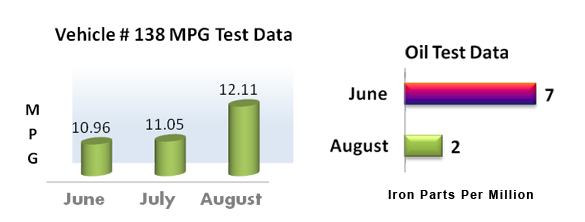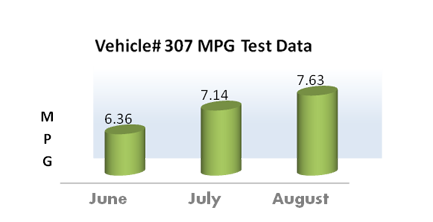


GO-15-HF Lab Test Report
Engineous USA Inc., and the city of Bellflower, California, entered into a 3-month control test of the engine metal conditioner GO-15-HF in 7 of its vehicles. The test measured the change in miles per gallon, and included complete oil analyses and emissions test for each vehicle.
It should be noticed that previously recorded statistics by the City of Bellflower (used for comparison), covered a full year, whereas the GO 15 test was conducted during the heat of the summer, when increased use of the air conditioning in the vehicles impact vehicle efficiency.
The steps taken:1. Prior to adding GO 15, oil samples ware taken from each of the test vehicles and sent to an independent laboratory, Herguth Laboratories Inc., who recorded the data.
2. A smog or snap idle test was taken and recorded for each vehicle.
3. The oil was changed in each vehicle and GO 15 was added.
4. At the end of the 3-month period, oil samples ware again taken from each vehicle and sent out to Herguth Laboratories Inc. for analysis.
5. Smog or snap idle tests were again recorded at the end of the test period.
Attached reports from Herguth Laboratories Inc. are synopsized below:
Test miles driven: 2,775 miles
Average MPG:
July 2005 - June 2006 - 9.52 mpg
July 2006 - June 2007 - 10.40 mpg
Test Period:
June - 10.96 mp8
July - 11.05 mpg
August - 12.11 mpg
Comparisons:
2005/2006 vs. 2006/2007 (9.52 mpg /10.40 mpg) = Plus 9%
2006/2007 vs. Test
(10.40 mpg /11.37 mpg) = Plus 9%
There was an 11% increase in mpg during the test period. Results showed an improvement from 2006 to the test period of 9%. Oil samples showed a decrease in iron from 7 to 2 parts per million.
Test miles driven: 2,068 miles
July 2004 - June 2005 – 6.73 mpg
July 2005 - June 2006 – 6.83 mpg
July 2006 - June 2007 – 7.27 mpg
Test Period:
June – 7.10 mpg
July – 6.76 mpg
August – 8.01 mpg
Comparisons:
July 2004/June 2005 vs. July 2005/June 2006
(6.73 mpg / 6.83 mpg) = Plus 2%
July 2005/June 2006 vs. July 2006/June 2007
(6.83 mpg / 7.27 mpg) = Plus 6%
July 2006/June 2007 vs. Test
(7.27 mpg / 7.15 mpg) = Drop 2%
Test period shows a 13% gain from June to August and will continue to improve with additional mileage. Vehicles showed improvement in emission snap idle test. The average opacity went from 00.9 to 00.2 showing less pollution being sent into the air, Oil samples showed a decrease in iron from 12 to 8 parts per million, and lead from 3 to 2 parts per million.
Test miles driven: 2,039 miles
July 2004-June 2005 – 7.23 mpg
July 2005 - June 2006 – 7.25 mpg
July 2006 - June 2007 – 7.24 mpg
Test Period:
June – 6.36 mpg
July – 7.14 mpg
August - 7.63 mpg
Comparisons:
2004/2005 vs. 2005/2006 (7.23 mpg / 7.25 mpg) = +/- 0%
2005/2006 vs. 2006/2007 (7.25 mpg / 7.24 mpg) = +/- 0%
2006/2007 vs. Test (7.24 mpg / 7.04 mpg) = Drop 3%
Vehicle was very consistent in mpg from 2004 thru the test period. During the test period there was a 20% improvement in mileage. The truck also had improvement in the emission snap idle test. The opacity was reduced from 00.5 to 00.4. Oil samples maintained satisfactory conditions.
Test miles driven: 2,962 miles

3 MONTH TEST EVALUATION
All MPG numbers on each vehicle that were extreme, either high or low have been removed from the averages.
The oil samples taken from the vehicles showed major decreases in iron deposits* Additional improvements were recorded in the copper and lead levels.
The average mileage steadily increased in vehicles, 138, 201, 307, and should continue to improve as additional miles are put on. The yearly averages in previous years were based on a 12-month period. Our test period covered some of the hottest months of the summer. The charts will show that each month the mpg increased during the test period.
ANALYSIS RECOMENDATION
○ MPG will continue to increase as the mileage increases in the vehicles.
○ MPG will increase in the vehicles that have air conditioning when the ambient temperature gets back to normal yearly averages.
○ Smog results will improve once GO 15 has time to bond with the metal.
○ The treatment of the rear end differentials and standard transmissions will also increase the fuel economy.
○ The results of this three-month test should be proof of the products advantages and cost savings. We would recommend the treatment of the whole fleet.
○ By using GO 15, you will financially benefit in the area of fuel and repairs, as well as contributing to cleaner air quality.





 GO-15-HFoz Bottle
GO-15-HFoz Bottle


